-
THE OUTLINE: (THE TEMPLATE, THE PLAN VIEW)
The outline of a surfboard represents the shape of the perimeter of the board, the equivalent terms are planform and template. It is defined by :
• The length of the board
• The maximum width.
We then give as information
• The position of this maximum width (wide point) in relation to the center of the length of the board. Two other dimensions end up describing the outline,
• The width of the nose
• The tail width taken respectively is one foot (30.48 cm) from the front end of the board and one foot from the rear end of the board..
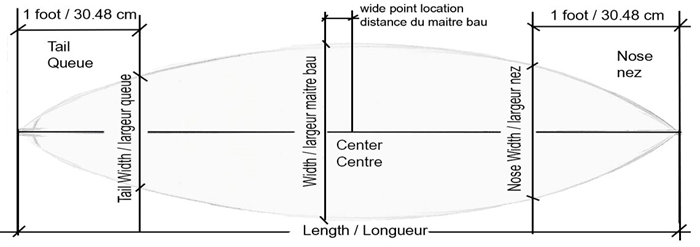
the dimensions defining the outline
THE OUTLINE SURFACE : The surface of the outline partly determines the waterline volume (the other determining factor being the thickness of the board)
A large surface therefore allows a large flotation. The drag force opposing the movement of the rower is made up of 2 main components: frictional drag and shape drag. (See drag chapter) At train speeds, frictional drag remains negligible and shape drag is predominant. It is caused by changes in direction and speed, constrained by shapes not parallel to the displacement. These non-parallel shapes constitute the frontal surface (submerged surface projected perpendicular to the displacement).
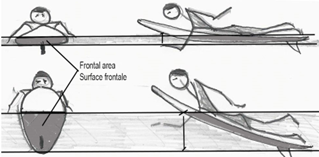
The shape hydrodynamic drag force is proportional to the frontal area and the square of the speed. Rowing with a surfboard, whose buoyancy volume keeps the surfer's entire body out of the water, is therefore easier than with a small board that lets part of the surfer's body sink, because the frontal surface is less important.
Floating therefore allows you to better use your rowing energy and to reach higher speeds. It will thus be easier to travel long distances or to catch up with the wave of the wave in order to go on it. The low shape drag of a high flotation board will thus allow you to be propelled by a wave with a very low slope, or to take the wave ahead of its peak, because the slightest component of the force of gravity resulting from a slight slope, will quickly exceed the drag. The surfer will therefore be able to take the necessary speed to go into planing and perform his take off.
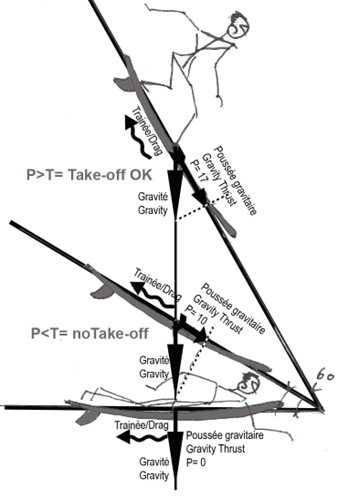
Gravity drag comparative diagram following slope: If P (thrust resulting from the gravity projected on the slope), is greater than T (the drag of resistance to progress), the board accelerates, the take off is then possible. The surface also determines planing lift: A large surface makes it possible to reach or maintain planing with less speed, the board with a large surface sinks and brakes less in the maneuvering phases where the speed drops.
The length of the outline: The advantages / disadvantages of length :
Flotation: The length therefore brings the advantages of the buoyancy volume, but for the same submerged volume, the frontal surface of a long board is less than that of a wide board, so we will gain significantly in form drag when paddling (especially if the surface is choppy) and will increase the theoretical hull speed limit. In planing, length is no longer an advantage, as we will see in the chapter dealing with friction drag and the Lindsay Lord experiments.
submersion of the rocker curve not adapted to the wave curve: A long board will find its place in a big wave and/or a weak curvature, but it will swallow if the wave is hollow and of small size.
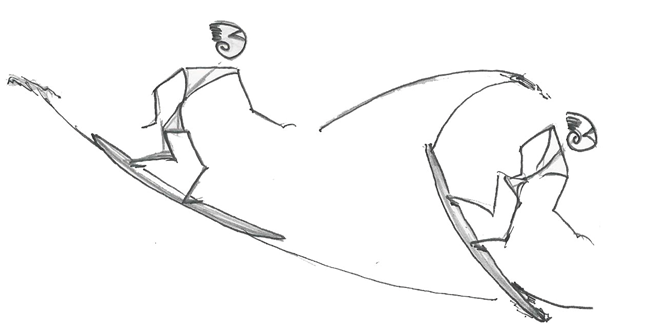
: wave length and curve
Considering only the dynamic aspect of inertia, without going into hydrodynamics, a long board requires more energy to be put into rotation because it is heavier but also because of the distance between the pivot point (which we assume here at the level of the fins) and the center of inertia of the board. The maneuvering effort is determined by this distance.
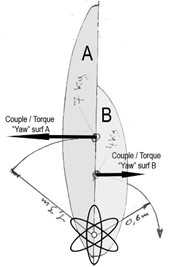
To give board A a speed of 1 revolution/sec around its center of gravity, a force of 3.8 kg would have to be applied at 1 meter from the center of rotation for one second. If we place the pivot point 1.3m from the center of gravity of board A, this force increases from 3.8 kg to 12 kg To give board B a speed of 1 revolution/sec around its center of gravity, we would have to apply a force of 0.3 kg at 1 meter from the center of rotation for one second. If we place the pivot point 0.6m from the center of gravity of board B, this force increases from 0.3 kg to 1.2 kg.
The variation of the distance between the center of inertia of the board and the pivot point is therefore already of a very great influence on the maneuverability in terms of inertia, we will see that this pivot point is also very influential on the 'hydrodynamic. It therefore seems wise to take care of the placement of this pivot before worrying about a difference of 0.01 kg between carbon or classic technology in the choice of fins.
It should be noted that a forward position of the pivot point reduces the torque to be produced and therefore improves maneuverability in Yaw. This is what happens when the daggerboards are moved forward or when the daggerboards have an automatic orientation system which modifies the position of the center of the curve. (See ADAC system)
• Sequence of maneuvers : 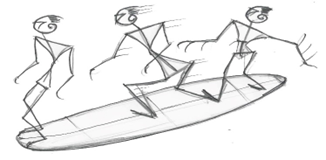
The position of the surfer on a long board must be moved from the back, during the tight turns phases, to the front to seek acceleration. This movement can be used to perform dance steps over the length, but the intuitiveness of the maneuvers is greatly affected. Shortboards allow sequences of maneuvers without necessarily moving.
• Duck bar passage : 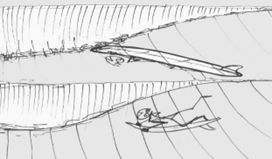
A long board can be impossible to submerge when ducking the bar, and it can become very energy-consuming to pass the bar without taking advantage of this maneuver. All that remains is to turn the board into a barrel and squeeze it with all your strength so as not to send it over the other surfers in the spot or let go of the board if the wave is too powerful.
To sum up, the advantage of a short board lies mainly in the maneuverability without moving the feet and the passage of the bar in duck. The advantage of a long board is mainly in the ease of catching more waves and stability. One method of choice is to get the board as long as possible, to catch as many waves as possible depending on the physical and wave conditions, but short enough to allow room for the maneuvers the surfer desires to produce. Choosing a board that is too short to have great maneuverability is nonsense if you miss 50% of the waves of the day...
The width of the outline :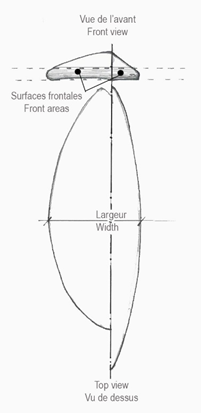
When paddling, for an equivalent flotation, a wide board has a larger frontal surface, and therefore generates more shape drag than a long board. When the speed increases and you enter planing, the shape drag becomes less important because a large part of the submerged frontal surface disappears. Lindsay Lord's tests described in a previous chapter, giving the drag as a function of the Width/Length ratio, tell us that the optimal ratio is around 0.5, and that above this ratio, the width becomes penalizing when the surface of the the water is irregular. This is related to the frontal area hitting the chop, which a long, narrow board cuts through better. One of the biggest advantages of the width is the ability to maintain flotation and planing even in maneuvers where you rely solely on the tail (rear) of the board to lift the front of the board. plank and turn radically, as in the "tick-tock" maneuvers in skateboarding. In these phases of tight turns, at reduced speed, in support on the back, the board floats more if it is wide. This avoids sinking and blocking the board.
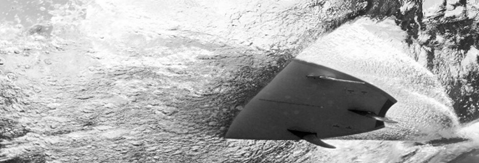
Yaw maneuverability gain : Another advantage in terms of maneuverability of the boards with the large width, is the possibility (with equal outline surface) of creating a stronger outline curve.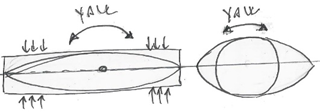
One can easily imagine that it is easier to spin a floating disc than a long rectangular board. We will therefore gain in “yaw” maneuverability on a wide outline with a tight radius of curvature.
However, the rounded outline at the front of the board tends to push the rail out of the water as the speed increases. This can make the rail difficult to submerge, resulting in a board that slips forward. Without rail attachment at the front, it is impossible to take advanced positions generating speed. We will favor forms of parallel rails for speed.
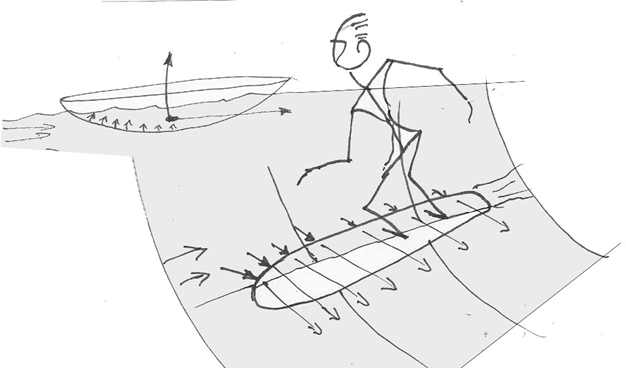
hydrodynamic thrust forces on the front part of the rail. The front curve of the outline tends to eject the rail from the water. The hydrostatic thrust (floating of the submerged volume) also tends to push the submerged part out of the water in a direction perpendicular to the surface.
Loss of maneuverability inRoll : A large width increases the rocking force in "roll" necessary to sink the rail, by increasing the volume to be submerged and the distance between the center of the board and the rail. It is therefore more difficult to push the rail deep into the wave to exploit accelerating carved turns and/or to quickly switch from rail to rail. Wide boards are therefore naturally more stable in Roll, they sail flatter and more difficult to exploit the effects of cut curves that the rails combined with the rocker curve can provide. We will see in the optimizations how a “hydroactive” type rail can free us from this width problem. The term “clunky” designates this difficulty of passing from rail to rail, by the sound that the board makes when it slams when passing from its stable flat position. A basic rule indicates that if the foot must be brought closer to the rail to obtain the grip, it is that the board is too wide, or that the fins are badly implanted because they generate cant (see chapter fins). Couple diagram of Roll/Roll wide board narrow board:
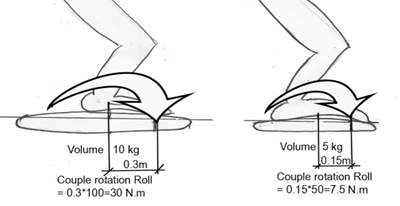
Outline : Influence of the position of the wide point poition
The position of the wide part of the board determines the area where the lift will be the most important. The further this position is from the center, the more we mark the style of surfing that we can practice with.
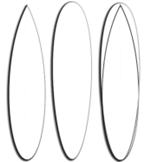
• Placed on the back of the center of the board, the wide part will allow the surfer a more rearward position. It will therefore limit sinking and braking for a surfing style favoring tricks and maneuvers using support on the rear foot to turn. This type of surfing on the back favors the demonstrative figures appreciated by the competitors.
• Placed on the front of the center of the board, the wide part allows more forward support and faster surfing. The maneuvers exploit the shapes: By pressing on the rail and the curve of the rocker, the surfer produces propulsive, incisive and precise cut turns. This type of surfing is more in tune with the shapes and hydrodynamic effects of the board and exploits the fluidity of the wave in a more instinctive surf than demonstration.
• By mixing the two, we produce a versatile surf..
The outline therefore determines the type of wave and surf for which the board is intended. Here are some basic types of boards whose outline varies according to the style of surfing you want to practice: :
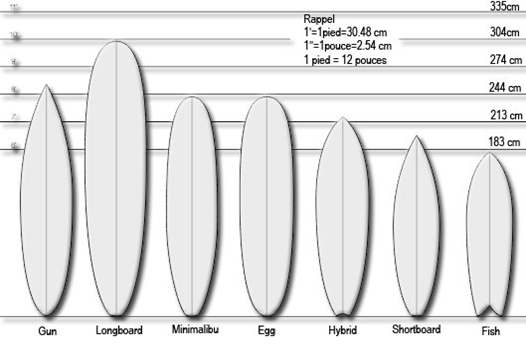
OUTLINE gun :
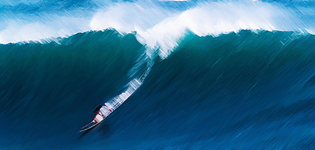
Big wave surfing, the origin of its name “Gun” would be due to a reflection made in 1956 by a shaper working on a form intended for big waves: “You don't hunt the elephant (big waves) with a gun for children, we use an elephant gun! "Elephant Gun" remained the name Gun. So this elephant gun is very thin at the back and narrow, this small width offers very little frontal surface, this allows you to reach high speeds. The narrow outline makes it easy to switch from rail to rail (Roll/Roulis) and to sink the rail deeply. Rarely equipped with side fins close to the rail because they induce cant. A single central fin provides a centered support increasing the sinking of the rail and the exploitation of the rocker in the cut curves. Its narrow Pintail with low lift, sinks and digs a furrow which stabilizes the trajectory by maintaining the rear. The rearward position of the fin further increases this directionality. This type of board can reach more than 3 meters to hunt mammoths!
OUTLINE long bord : (ou Malibu)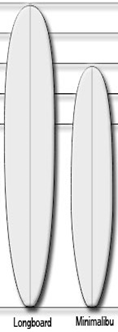
the surf of the origins, imported by Duke in California with the surf, it was abandoned during the shortboard revolution, but has come back in force since 1990 with a lightness and hydrodynamic qualities that make it easier to surf than at the origins. A large rounded nose clearly distinguishes it from the Gun. Its width provides the flotation and the planing surface giving it, respectively, a faster oar, and the possibility of surfing low slopes. Its flotation prohibits the duck, but allows it to take the waves ahead of the peak with little effort. The number of waves that it becomes possible to surf in a session therefore becomes greater than with a shortboard. The inertia of this type of board needs to be tamed and used, the longboarder moves from the front to the back of the board depending on the speed or maneuverability he is looking for. It allows you to go from fairly big conditions to small wave conditions where tricks and various steps on the board are an art in itself. Shapers' longboards can be very light and the levels of tricks performed by pro longboarders no longer have much to envy to shortboards!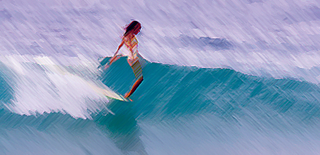
OUTLINE mini Malibu : wider and thicker than a short board, it allows better paddling thanks to its flotation. It thus allows older surfers to keep a chance to catch waves in territories populated by young shortboarders, while keeping more radical maneuvers than a Malibu (longboard)! An identical tail and nose width, but a wide point (beautiful master) far enough back to maintain a fairly radical turning ability at the rear.
OUTLINE Egg : a mini Malibu with a more advanced wide point, so possible support further forward without burying. This board is therefore intended for faster but less radical surfing than the Malibu.
OUTLINE hybrid :Board that connects to the mains to go up to the peak thanks to its electric motor. It recharges its battery when its propeller spins upside down as it rolls down the wave. Has a citrus press and coffee grinder that makes very good cappuccinos (optional). More seriously, this type of board offers a compromise between Fish Egg shortboard/mini Malibu. Less radical than a shortboard, it keeps a nose suitable for ducks and a rear wide enough for maneuvers in back support, but allows advanced support from a wide point in front and a fairly wide nose. It is comparable to a larger Fish with a narrower tail. It offers lift and maneuverability and allows you to surf more types of waves than the Fish.
OUTLINE short Board :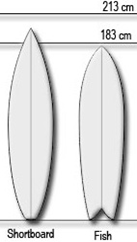
between 1.5 and 2.2 meters, it is the most widespread board since the shortboard revolution initiated in 1966 by the radical figures of Nat Young at the world championships. The shapers linked to this revolution are the Australian Bob McTavish, and the Californian George Greenought. More difficult to row because of its low buoyancy, its low inertia and its small surface make it very maneuverable without making any movement on the board. The ducks are easy to dive thanks to a pointed nose and a reduced volume, but its low lift implies a constant search for speed and very fast sequences so that it does not sink into the dead spots (zone where the board is almost stopped). The term "engagement" defines the revolutionary style of shortboard surfing in comparison to pre-existing surfing, where the "hang ten" or "hang five" were the most extreme figures.
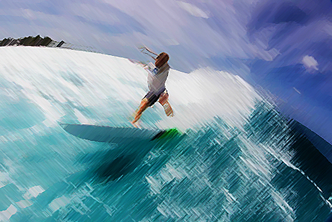
Radical shortboard maneuvers tend to slow and sink the board in skid-type turns. The stimulus will therefore have to be produced by pumping. The contribution of drive, maneuverability and pump acceleration generated by dynamic fins (see ADAC system), lend themselves particularly well to this type of surfing..
OUTLINE Fish : 
It is a wide shortboard with a swallow tail tail. Ideal for beach break and small fast waves. Thick and wide, the Fish has a flotation that makes paddling easier. Its advanced "wide point" (master bau) allows it to get support providing speed without burying, its tailcoat extends the rail and its drive effect, while offering width to avoid sinking the rear in low turns. speeds. The low rocker is matched to wave curvature to limit frontal area and drag. The fins are symmetrical profiles and parallel to the axis of the board to generate a minimum of drag. The curvature and wave speed necessary to propel this small surface in planing make it difficult to use it in the less pronounced troughs of medium-sized waves..